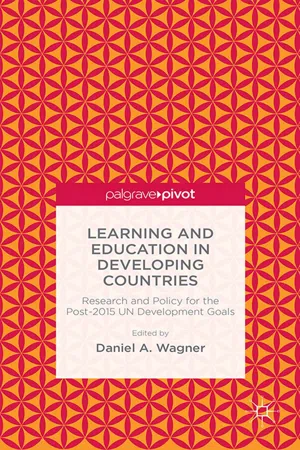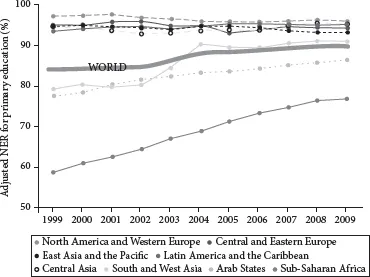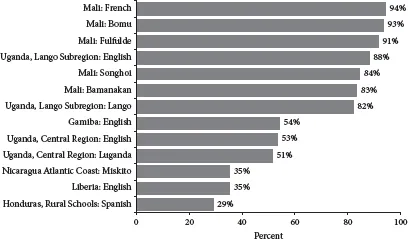
eBook - ePub
Learning and Education in Developing Countries: Research and Policy for the Post-2015 UN Development Goals
Research and Policy for the Post-2015 UN Development Goals
This is a test
- English
- ePUB (mobile friendly)
- Available on iOS & Android
eBook - ePub
Learning and Education in Developing Countries: Research and Policy for the Post-2015 UN Development Goals
Research and Policy for the Post-2015 UN Development Goals
Book details
Book preview
Table of contents
Citations
About This Book
This comprehensive and up-to-date review of learning and educational quality in developing countries, written by 16 highly knowledgeable specialists from around the world, provides policymakers and researchers accessible perspectives with the Millennium Development Goals in mind.
Frequently asked questions
At the moment all of our mobile-responsive ePub books are available to download via the app. Most of our PDFs are also available to download and we're working on making the final remaining ones downloadable now. Learn more here.
Both plans give you full access to the library and all of Perlego’s features. The only differences are the price and subscription period: With the annual plan you’ll save around 30% compared to 12 months on the monthly plan.
We are an online textbook subscription service, where you can get access to an entire online library for less than the price of a single book per month. With over 1 million books across 1000+ topics, we’ve got you covered! Learn more here.
Look out for the read-aloud symbol on your next book to see if you can listen to it. The read-aloud tool reads text aloud for you, highlighting the text as it is being read. You can pause it, speed it up and slow it down. Learn more here.
Yes, you can access Learning and Education in Developing Countries: Research and Policy for the Post-2015 UN Development Goals by D. Wagner in PDF and/or ePUB format, as well as other popular books in Education & Comparative Education. We have over one million books available in our catalogue for you to explore.
Information
Topic
EducationSubtopic
Comparative Education1
Learning First: An Introduction
Daniel A. Wagner
Abstract: The broad imperative to improve learning for all children is one of the greatest challenges of the 21st century. Indeed, learning has been part of the 2015 United Nations Millennium Development Goals and will likely have an increased visibility in the post-2015 era, when quality of education will receive enhanced attention. But what is learning? Does learning happen the same way around the world? What are the social and economic factors that impact learning and quality of education. How do these factors affect the most disadvantaged populations? These and other questions are central to a debate on the nature and role of learning around the world. Research on these issues in developing countries will be needed in order to foster informed educational policy development.
Wagner, Daniel A. Learning and Education in Developing Countries: Research and Policy for the Post-2015 UN Development Goals. New York: Palgrave Macmillan, 2014. DOI: 10.1057/9781137455970.0006.
Parents, educators, government ministers, and policymakers in all contexts and countries around the world are concerned with learning, and how to improve it. There are many reasons for this, but none is more important than the fact that learning is at the heart of success at the individual, community, and global levels. Some might say that this has been true since the Industrial Revolution (or longer)—yet few would deny that the need to improve learning is among the most important goals in the world today. The present volume seeks not only to explain why this is the case but also focuses on what we need to know—that is, what research is needed—in order to improve learning tomorrow, particularly among those children most in need.
Learning First is the title of this introduction, as it suggests that learning should be the foremost goal of education policies worldwide.1 Also, the choice was derived from a recently announced effort of the United Nations called the Global Education First Initiative.2 The distinction, as will be seen, is an important one. Education has been a shared policy goal ever since the development of modern public education. Indeed, getting all children into school has been a key international policy goal. We argue here that access to schooling—while very important—is not enough. Learning—and how to improve it—should be our fundamental international educational goal.
International goals
The World Conference on Education for All in Jomtien (Thailand) was a watershed moment in international education and development. Held in 1990, the conference embraced two key challenges: first, to significantly increase access to education of children in poor countries; and second, to promote the quality of learning in education. A decade later, at the Education for All (EFA) conference in Dakar in 2000, these same two challenges were enlarged in a more detailed list of six education targets.3 They were reinforced again in the UN Millennium Development Goals (MDGs) for 2015, where universal primary education was made the second of eight major goals.4 These global efforts led not only to substantive increases in international development assistance to education but also to greater attention in the broader public arena regarding the importance of children’s learning on a global scale.
Consequently, during the past two decades since the Jomtien Conference, major progress in educational development has been made in low-income countries.5 In Sub-Saharan Africa, for example, primary school enrollment has climbed from under 60 percent to nearly 80 percent, putting millions of additional children in school (Figure 1.1), and girls’ access to education increased, particularly in South and West Asia (Figure 1.2). The impressive accomplishment of putting more children in school—and many from poor communities—resulted in a number of unintended consequences. In short order, there appeared a greater need for more infrastructure and supplies (e.g., better-functioning schools, adequate textbooks) and more trained teachers. With the rapidity of growth in enrollment, it became difficult to support a parallel growth in the number of qualified teachers, to maintain reasonable class sizes, and—most relevant to the present discussion—to assure that children had access to high quality learning experiences.
Even before the Dakar conference in 2000, it was manifestly clear that the quality of education was a serious concern in low-income countries. For example, a World Bank national household survey in rural Bangladesh found that three years of schooling had approximately zero value in terms of learning achievement.6 In other words, the effort of getting kids into school had little or no payoff with respect to educational gains. That was in 1999. Today, after fifteen years of substantial investments in education development, new studies are appearing with the same basic result: In many countries, children cannot read a single word, even after multiple years of attending school (Figure 1.3), leading to a very poor prognosis for future academic success.7 Clearly, the Jomtien goals to promote the quality of learning provided a baseline for the MDGs for 2015. There seems little doubt that the focus on the quality of education, and of learning, will be central to the post-2015 development goals.

FIGURE 1.1 Adjusted net enrollment rate for primary education by region, 1999–2009
Source: UNESCO Institute of Statistics (2011), p. 10.
Note: East Asia and the Pacific and South and West Asia: UIS estimates based on data will limited coverage for the reference year, produced for specific analytical purposes.

FIGURE 1.2 Change in gender parity in primary completion rates by region, 1999–2009
Source: UNESCO (2012), p. 28.
Note: *1990 data for Central Asia refer to 1991.

FIGURE 1.3 Percentage of children who cannot read a single word, 2008–2009
Source: Adapted from Gove & Cvelich, 2010. p. 10.
The global learning crisis and a research response
In 2011, the Brookings Institution Center for Universal Education published A Global Compact on Learning: Taking Action on Education in Developing Countries, which stated that there is a “global learning crisis—which affects children and youth who are out of school with limited learning opportunities and those who are in school but not learning the skills they need for their futures.”8 The Brookings report goes on to say that there are “three priorities to improve learning for all children and youth, including those out of school: (1) help children get an early start on learning in life, (2) ensure that basic literacy and numeracy are learned in school, and (3) equip young people with relevant skills for their lives and livelihoods.”
These three priorities, coupled with other policy discussions concerning the future of the UN MDGs after 2015, provide the basis for renewed efforts to improve learning. However, it is one thing to set goals and another to know how to achieve them. Research and researchers have important roles to play. The significance of rigorous, empirical evidence for innovations in social programming has been well established in recent decades.9 Research not only provides new paths to innovation but can also reduce wasted investments in time and resources on methods that no longer work.
Some limitations. This volume is about learners and learning. A first limitation is t...
Table of contents
- Cover
- Title
- 1 Learning First: An Introduction
- 2 Literacy and Numeracy Skills among Children in Developing Countries
- 3 Information and Communications Technologies for Improving Learning Opportunities and Outcomes in Developing Countries
- 4 Fragile and Conflict-Affected Situations
- 5 Nonformal Education and Learning
- 6 Assessment of and for Learning
- 7 Conclusion: Toward a Learning Research Agenda
- References
- Index